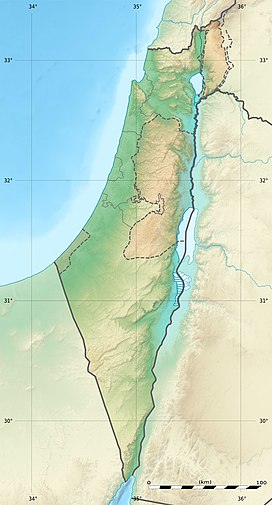Mount Hermon (Arabic: جبل الشيخ, Jabal el-Shaykh,"mountain of the chief" and "snowy mountain", Hebrew: הר חרמון, Har Hermon) is a mountain in the Anti-Lebanon mountain range. Its highest point is 2,814 m (9,232 ft) above sea level. This summit is on the border between Syria and Lebanon.[1] Parts of the southern slopes fall within the Golan Heights, an area under Israeli control since the June 1967 Six-Day War.
| Mount Hermon | |
|---|---|
 Mount Hermon, viewed from Mount Bental in the Israeli controlled Golan Heights | |
| Highest point | |
| Elevation | 2,814 m (9,232 ft) |
| Prominence | 1,804 m (5,919 ft) |
| Listing | Country high point Ultra |
| Geography | |
| Location | {flag |



Geography
The mountain is actually a cluster of mountains with three distinct summits, each about the same height. The Anti-Lebanon range extends for approximately 150 km (93 miles) in a northeast-southwest direction, running parallel to the Lebanon range on the west. The Hermon range covers an area of about 1000 square km, of which about 70 km² are under Israeli control. Most of the portion of Mount Hermon within the Golan Heights constitutes the Hermon nature reserve.
The mountain forms one of the greatest geographic resources of the area. Because of its height it captures a great deal of precipitation in a very dry area of the world. The Jurassic limestone is broken by faults and solution channels to form a karst topography. Mount Hermon has seasonal winter and spring snow falls which cover all three of its peaks for most of the year. Melt water from the snow-covered mountain's western and southern bases seeps into the rock channels and pores, feeding springs at the base of the mountain, which form streams and rivers. These merge to become the Jordan River. Additionally, the runoff facilitates fertile plant life below the snow line, where vineyards and pine, oak, and poplar trees are abundant.
The springs, and the mountain itself, are much contested by the nations of the area for the use of the water. Mount Hermon is called the "gray-haired mountain," or the "mountain of snow." It is also called "the eyes of the nation" in Israel because its elevation makes it Israel's primary strategic early warning system.citation
Biblical references
Mount Hermon was called Senir by the Amorites and Sirion by the Sidonians (Deuteronomy 3:9 and see commentary of Rashi ad loc; Psalms 29:6; 1 Chronicles 5:23; Song 4:8; Ezekiel 27:5), names which may signify a "coat of mail" or "armor". The mountain served as the northern boundary of the Promised Land (Deuteronomy 3:8) and also was the northern limit of the conquest (Joshua 11:17, 12:1, 13:5). The high places of Mount Hermon were used by the Canaanites in Canaanite mythological rituals. They referred to the mountain as Mount Ba'al-Hermon (Judges 3:3). It is also called Mount Sion or Mount Siyon (Deuteronomy 4:48).
New Testament
The Gospels tell of Jesus and his disciples journeying north from Bethsaida on the Sea of Galilee to the city of Caesarea Philippi at the southern base of Mount Hermon (Matthew 16:13; Mark 8:27). There, Jesus revealed to them his purpose to build his Church and to go to Jerusalem to die and be resurrected (Matthew 16:18–21). Mount Hermon is a possible site of the Transfiguration, where Jesus, according to the New Testament, took three of his disciples, Peter, James, and John, up on a high mountain for prayer. Jesus is reported to have became radiantly white and conversed with Moses and Elijah, who had appeared beside him. In the Book of Enoch, Mount Hermon is the place where the Grigori ("Watcher") class of fallen angels descended to Earth. They swore upon the mountain that they would take wives among the daughters of men and return (Enoch 6).
Arab-Israeli conflict
The Israeli controlled sector was captured by Israel in the Six-Day War of June 1967. It was regained by Syria on October 6, 1973, the first day of the Yom Kippur War, following the First Battle of Mount Hermon. Israel recaptured both the formerly Israeli controlled sector and the pre-Yom Kippur War Syrian controlled sector on October 21, during Operation Dessert.[2] The pre-Yom Kippur War Syrian controlled sector was returned to Syria after the war.[3] The Israeli controlled sector of the mountain is patrolled by the Israel Defense Forces and the Israel Police, and the Israeli Security Forces maintain a strategic observation post for monitoring Syrian and Lebanese military activity near Mitzpe Shlagim ("Snow Lookout"), which is at an elevation of about 2,224 m (7,300 feet). Its adjacent peak, at 2,236 m, is the highest elevation on Israeli controlled territory.
Ski resorts
Since 1981, the Israeli controlled region has been governed under Golan Heights Law. Mount Hermon has Israel's only ski resort, including a wide range of ski trails at novice, intermediate, and expert levels. It also offers additional winter family activities such as sledding and Nordic skiing. Those who operate the Hermon Ski area live in the nearby Israeli settlement of Neve Ativ and the Druze town of Majdal Shams. The ski resort has a ski school, ski patrol, and several restaurants located at either the bottom or peak of the area. The Syrian government has plans to develop a multi-billion dollar ski resort on the slopes of the mountain.[4]
See also
References
- ^ ACME Mapper terrain display
- ^ "The Yom Kippur War". Ynetnews. 2008-11-11. Retrieved 2008-11-24.
- ^ "Syria". Ynetnews. 2007-12-23. Retrieved 2008-11-25.
- ^ Middle East Online
External links
- Photos of Mount Hermon ski resort (in a snowless season)
- Map of the ski resort
- Home page of the ski resort Hermon, English
- Home page of the ski resort Hermon, Hebrew
